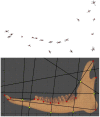Shape Analysis as an Additional Tool in Roe Deer (Capreolus capreolus) Management: A New Approach Based on the Relationship between Mandible Shape and Trophic Resources
- PMID: 34072485
- PMCID: PMC8228368
- DOI: 10.3390/ani11061611
Shape Analysis as an Additional Tool in Roe Deer (Capreolus capreolus) Management: A New Approach Based on the Relationship between Mandible Shape and Trophic Resources
Abstract
The analysis of body shape variability has always been a central element in biology. More recently, geometric morphometry has developed as a new field in shape analysis, with the aim to study body morphological variations and the identification of their causes. In wildlife management, geometric morphometry could be a useful tool to compare the anatomical structures of an organism and quantify its geometric information in order to relate them to environmental factors, thus identifying the causes and effects of the variation and acting management and/or conservation plans. The aim of our study is to evaluate the relationship between roe deer mandible shape and trophic resources available during autumn and winter. We applied a geometric morphometry approach consisting of a Relative Warp analysis of landmark data in 26 roe deer fawn mandibles. Each sample was assigned to an age category and to an environmental category based on the territory carrying capacity. The mandible shape of samples under 8 months of age is likely influenced by the availability of trophic resources. Our findings suggest that the mandible shape is a reliable instrument to assess resource availability. Geometric morphometry could thus represent an additional tool for roe deer management.
Keywords: geometric morphometry; mandible; roe deer; shape analysis; trophic resources; wildlife management.
Conflict of interest statement
The authors declare no conflict of interest.
Figures




Similar articles
-
Historical biomonitoring of fluoride pollution by determining fluoride contents in roe deer (Capreolus capreolus L.) antlers and mandibles in the vicinity of the largest Slovene thermal power plant.Sci Total Environ. 2010 Dec 15;409(2):430-8. doi: 10.1016/j.scitotenv.2010.10.012. Epub 2010 Nov 20. Sci Total Environ. 2010. PMID: 21093890
-
Spatial variation in springtime food resources influences the winter body mass of roe deer fawns.Oecologia. 2003 Nov;137(3):363-9. doi: 10.1007/s00442-003-1364-7. Epub 2003 Aug 15. Oecologia. 2003. PMID: 12920639
-
A Novel Method for Increasing the Numerousness of Biometrical Parameters Useful for Wildlife Management: Roe Deer Mandible as Bone Model.Animals (Basel). 2020 Mar 11;10(3):465. doi: 10.3390/ani10030465. Animals (Basel). 2020. PMID: 32168772 Free PMC article.
-
Biometric analysis applied to three age classes of roe deer (Capreolus capreolus) in a population of central Italy.Ann Anat. 2025 Jun;260:152401. doi: 10.1016/j.aanat.2025.152401. Epub 2025 Mar 15. Ann Anat. 2025. PMID: 40096870
-
Embryonic diapause in roe deer: A model to unravel embryo-maternal communication during pre-implantation development in wildlife and livestock species.Theriogenology. 2020 Dec;158:105-111. doi: 10.1016/j.theriogenology.2020.06.042. Epub 2020 Jul 6. Theriogenology. 2020. PMID: 32947063 Review.
References
-
- Bookstein F.L. Morphometric Tools for Landmark Data: Geometry and Biology. Cambridge University Press; Cambridge, UK: 1997.
-
- Adams D.C., Rohlf F.J., Slice D.E. Geometric morphometrics: Ten years of progress following the ‘revolution’. Ital. J. Zool. 2004;71:5–16. doi: 10.1080/11250000409356545. - DOI
-
- Zelditch M.L., Swiderski D.L., Sheets H.D. Geometric Morphometrics for Biologists: A Primer. Academic Press; Cambridge, MA, USA: 2012.
-
- Webster M., Sheets H.D. A practical introduction to landmark-based geometric morphometrics. Quant. Methods Paleobiol. 2010;16:163–188. doi: 10.1017/S1089332600001868. - DOI
LinkOut - more resources
Full Text Sources

